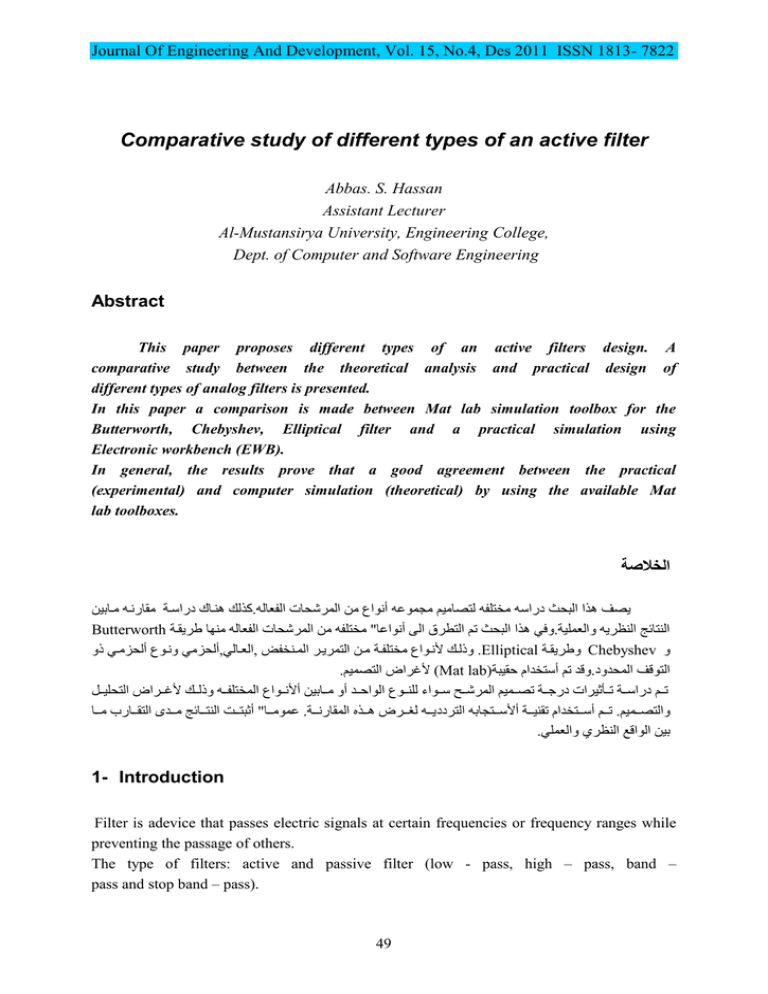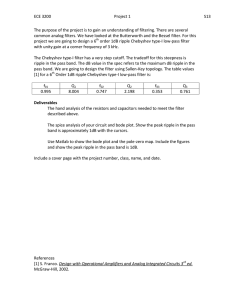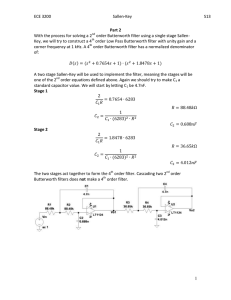Comparative study of different types of an active filter
advertisement

Journal Of Engineering And Development, Vol. 15, No.4, Des 2011 ISSN 1813- 7822 Comparative study of different types of an active filter Abbas. S. Hassan Assistant Lecturer Al-Mustansirya University, Engineering College, Dept. of Computer and Software Engineering Abstract This paper proposes different types of an active filters design. A comparative study between the theoretical analysis and practical design of different types of analog filters is presented. In this paper a comparison is made between Mat lab simulation toolbox for the Butterworth, Chebyshev, Elliptical filter and a practical simulation using Electronic workbench (EWB). In general, the results prove that a good agreement between the practical (experimental) and computer simulation (theoretical) by using the available Mat lab toolboxes. الخالصة كزلك هناا دساسا هقاسناه هاانُن.َصف هزا البحث دساسه هختلفه لتصاهُن هجوىػه أنىاع هن الوششحات الفؼاله Butterworth وفٍ هزا البحث تن التطشق الً أنىاػا" هختلفه هن الوششحات الفؼاله هنها طشَقا. ُالنتائج النظشَه والؼول ورلاك نناىاع هختلفا هان التوشَاش الوانخفط عالؼاالٍعألحوهٍ وناىع ألحوهاٍ رو.Elliptical وطشَقاChebyshev و .) نغشاض التصوُنMat lab( وقذ تن أستخذام حقُب.التىقف الوحذود تاان دساساا تاادرُشات دسماا تصااوُن الوششاااو سااىا للناااىع الىاحااذ أو هاااانُن أننااىاع الوختلفاااه ورلااك نغاااشاض التحلُاا ػوىهاااا" أربتاااا النتاااائج هاااذي التقااااس هاااا. تااان أساااتخذام تقنُا ا أنساااتجانه التشددَاااه ل اااشض هااازة الوقاسنا ا.والتصاااوُن .ٍنُن الىاقغ النظشٌ والؼول 1- Introduction Filter is adevice that passes electric signals at certain frequencies or frequency ranges while preventing the passage of others. The type of filters: active and passive filter (low - pass, high – pass, band – pass and stop band – pass). 49 Journal Of Engineering And Development, Vol. 15, No.4, Des 2011 ISSN 1813- 7822 Transfer function can be selected in accordance with certain mathematical rules so that corresponding low – pass filter curves all have( 3dB ) point at 1 rad (W=1) each curve represents a set of element values for an LC or active filter. this filter and it is response are said to be "normalized" to (1) rad., the general technique for designing filters is to first convert the filter requirement to normalized low–pass require, and select a satisfactory low– pass filter, then renormalized to required frequency range, if a high-pass, band–pass or band – stop filter is desired.[1,2] 2. Filters types and design 2.1. Butterworth filter design If offers the ability to design any filter type must be choosing the suitable order (n) which depends on the required pass band gain and stop- band attenuation. [3,4,5,6] …. (1) Where (n) is the order of the filter (number of poles), H (f) is the magnitude, f is stop-band cutoff frequency, fc is the cutoff frequency, as shown in Fig. (1). H (t) Magnetite 1.0 n=1 0.1 n=2 0.01 n=4 n=32 0.001 W 0.1 1.0 n=6 n=6 10 n=5 RADIANCe Fig (1) Normalized low pass Butterworth filter response curves Any filter is first designed proto type L.P.F then converted to the desired type using analog – to –analog transformation .as shown in Fig(2). Where: K1 = pass band gain. K2 = stop band gain. Wc= cutoff frequency. 50 Journal Of Engineering And Development, Vol. 15, No.4, Des 2011 ISSN 1813- 7822 Wr= rejected frequency. 1 K 1 10 log 1 wc 2n .............(2) 2n wr K 2 10 log 1 wc ...............(3) 10 k1 / 10 1 log 10 10 k 2 / 10 1 n 1 2 log10 w r ( 4) H (t) 0dB W Fig. (2) Prototype (L.P.F) 51 Journal Of Engineering And Development, Vol. 15, No.4, Des 2011 ISSN 1813- 7822 Proto tupe response Tansformed filter response 0dB Design equation 0dB w w 0dB 0dB w w 0dB 0dB w w 0dB 0dB w w Fig.(3) Show analog-to- analog transformation 52 Journal Of Engineering And Development, Vol. 15, No.4, Des 2011 ISSN 1813- 7822 2.2. Chebyshev filter design There are two types of Chebyshev filters , one containing a ripple in the pass band (type1 ) and the other containing a ripple in the stop – band (type 2 ). Atype1(unit band width)Chebyshev filter with a ripple in the pass band characterized by the following magnitude squared frequency. H (W ) 2 1 1 E Tn2 (W ) 2 Where TN (w) is the 4th order Chebyshev polynomial, (E) is pass-band ripple (dB) and it generated from the following recursive formula: Tn ( w) 2 xTn 1 ( x) Tn 1 ( x) n 2 with T0 ( x) 1, T1 ( x) x w Fig (4) Show the low – pass filter in Chebyshev. The magnitude of |Hn(w)| oscillates between 1 and 1/(1+E)2as shown in fig(4) as (W) goes ( 0 to 1 ) rad , but the periods of oscillations are not equal . 53 Journal Of Engineering And Development, Vol. 15, No.4, Des 2011 ISSN 1813- 7822 2.3. Elliptical filter design: Elliptical function filters contain zero as well as poles in the transfer function, these results in infinite rejection at stop – band frequencies near cutoff. The pass – band has ripples similar to Chebyshev filters and the stop – band has return lobes which are all equal in amplitude. For a given filter order (n).elliptical function filters have the steepest rate of descent to the stop – band theoretically possible Fig (5) compares Butterworth Chebyshev, and elliptic function filters of equivalent complexity. The steeper rate of roll of is obtained at the expense of return lobes, however these return lobes are acceptable. We most instances, providing they do not exceed the minimum attenuation required .elliptic function filter section are more complex and critical than the other types however , fewer sections are required for a given attenuation requirement then with other filter families for made rate filter requirements the all pole types are satisfactory. Where steeper filter requirements are specified. Elliptic function low – pass filters are normalized so that the attenuation of 1 rad is equivalent to the ripple rather than (3dB) Fig (6) illustrates a normalized elliptic function low – pass filter. A number of terns unique to these filters are used in fig (6) and are defined as follows. WS = lowest stop – band frequency of which a dB accurse (in radian). A dB = minimum stop – band attenuation in decibels. R dB =pass – band ripple in decibels. Elliptic function filters are categorized by these parameter in addition to order (n), since (WS, A dB, R dB) defined the pass – band and stop – band limits. Normalized frequency response curves are not required. The amplitude response is given by the equation (8): 54 Journal Of Engineering And Development, Vol. 15, No.4, Des 2011 ISSN 1813- 7822 Where: - Cn = elliptic polynomial of the first kind degree (n) E = constant that sets the pass – band and stop – band ripple. Fig ( 5 )Show L.P.F in Elliptical Fig ( 6 ) Show idea L.P.F , Butterworth L.P.F, Chebyshev L.P.F and Elliptical L.P.F 3.Experimental results In this experiment , we select the order ( n = 1,3,5,7 ) of filter and applying a MATLAB software to analysis and design the low – pass filter using Butterworth type , fig (7) shows the curve of ' LPF ' Butterworth type , and show the effect of multiple (order of filter ) on the frequency response for a low – pass filter using Butterworth type. Cascading filter (increase the order) increase the ultimate slop, but does improve the sharpness of the knee .All have not a very sharp 'knee' at the corner (cut off ) frequency (1000 Hz ) and do not really approach the ideal 'brick wall' filter characteristic the MATLAB program is shown appendix ( A1 ) is amplitude. 55 Journal Of Engineering And Development, Vol. 15, No.4, Des 2011 ISSN 1813- 7822 Fig (7) Show the curve of Butterworth L.P.F n= (1,3,5,7)by MATLAB In this experiment, we show the effect of multiple (order of filter) on the frequency response for a low – pass filter using Chebyshev type. We select the order (n = 1, 3 , 5 , 7)of filter and applying a MATLAB software to analysis and design this type of filter, fig (8) shows the curve of 'LPF'Chebyshev type using different order. Fig (8) Show the curve of Chebyshev 1 L.P.F n= (1,3,5,7) In this experiment, we select the order (n= 1, 3, 5, 7) of filter and applying a MATLAB software to analysis and design of the low –pass filter using Elliptical type. 56 Journal Of Engineering And Development, Vol. 15, No.4, Des 2011 ISSN 1813- 7822 Fig (9) shows the curves of L.P.F Elliptical type, and shows the effect of multiple (order of filter) on the frequency response for a low – pass filter using Elliptical type. Chebyshev Fig (9) Show the curve of Elliptic L.P.F n= (1,3,5,7) In this experiment, we show the comparative from of different types of L.P.F filter. Butterworth, Chebyshev, Elliptical with design specification shown be First: We need to design Butterworth L.P.F with the design specifications: Cut off frequency = 1000 HZ. Filter order = 5 or n = 5. Second: We need to design Chebyshev L.P.F with the design specifications: Cut off frequency = 1000HZ. Pass – band ripple = 0.5 dB. Filter order = 4 or n = 4. Third: We need to design Elliptical L.P.F with the design specifications: Cut off frequency = 1000 HZ. Pass – band ripple = 0.28 dB. Stop – band ripple = 39.48 dB. Filter order = 3 or n = 3. 57 Journal Of Engineering And Development, Vol. 15, No.4, Des 2011 ISSN 1813- 7822 Fig. (10) Show the different types of L.P.F filters. Butterworth response from equation(9): Tn ( jw) 1 1 w2n . ...............(9) We see this one property of Butterworth response is for all (n). Tn ( j1) 1 0.707 ...or ...(3.dB) 2 Where Tn is the 4th order Butterworth filter. In the Butterworth response f = 1000 Hz normalized frequency W (1) identifies the half – power frequency, while in the Chebyshev response at the same frequency or (w=1) identifies the end of the ripple band. These two frequency are different unless e=1 (max = 3dB) as shown in fig (10), the half – power frequency for the Chebyshev response is given by Eq. (10). 1 1 Wn cosh cosh1 n e .............(10) Where Wnα normalize frequency. We have observed that the Chebyshev response has a sharper cut off rate than the Butterworth response, and this suggests that a new response with equal ripple in both the pass–band and the stop–band (Elliptical filter). If we compared the Butterworth, Chebyshev, Elliptical under our specification, we show the Butterworth response it is necessary only that (n=5), for Chebyshev response that (n=4), and for elliptical response it is necessary only that (n=3). This is significant improvement fig (10) shows the comparative form of different types L.P.F filters. We can comprise between two response Butterworth and Chebyshev filters, as shown in fig (11). 58 Journal Of Engineering And Development, Vol. 15, No.4, Des 2011 ISSN 1813- 7822 Elliptical Butterwo rth Chebyshev 1000 2000 3000 4000 5000 6000 7000 8000 Fig (10) Shows the curves of Butterworth n=5, Chebyshev n=4 and Elliptical n=3 L.P.F MATLAB Fig(11) Comparison between two responses Butterworth and Chebyshe 59 Journal Of Engineering And Development, Vol. 15, No.4, Des 2011 ISSN 1813- 7822 4. Conclusion 1. Due to first experiment, A multipole filter can give any desired ultimate slop , but simple cascading still gives a softness, as shown in fig (7). 2. Due to second experiment, we conclude that the Chebyshev response provides a sharp (knee ) but has a ripple in the amplitude compared with Butterworth response which gives very flat amplitude, also there is a shifting in cut off frequency ( 1000 ) Hz in Chebyshev response at (-3 dB) , compared with Butterworth response , as shown in fig (8). 3. Due to third experiment, we conclude that the Elliptical response provides more sharp but has a ripple in the amplitude and in stop – band frequency compared with Chebyshev and Butterworth ,also there is a more shifting in cut off frequency(1000 ) Hz in Elliptic response at( -3 dB)compared with Chebyshev and Butterworth response , as shown in fig (9). 4. Due to fourth experiment, we conclude that if we want to design L.P.F in three methods we need an order design in Butterworth response (n =5) and for Chebyshev response (n= 4) and for Elliptical response (n = 3) we require to realize the specifications, as shown in fig (10, 11). References 1. VAN and NOSIKANI, "Design theory and data for electrical filters", 1997. 2. M.E.VAN, "Analog filter design" Saunders college publishing, 1982. 3. KAUFMAN and SEIDMAN, "Handbook of electronic calculations", 1979. 4. E.A.PARR, "Control engineering "Butterworth Hememan 1996. 5. "the student edition of MATLAB version 4 "by the MATH WORKS inc, 1998. 6. DELORES and M.ETTER, "engineering 1997. 7. PAUL HOROWHZ and WINFIELD HILL, "The art of electronic", Cambridge Low price edition, 1989. 60



